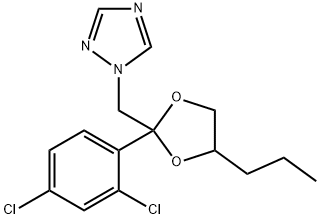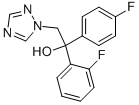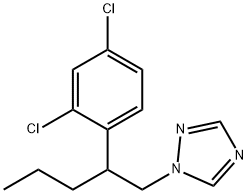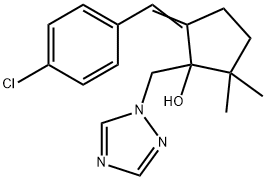IMIBENCONAZOLE
Synonym(s):4-Chlorobenzyl N-(2,4-dichlorophenyl)-1H-1,2,4-triazole-1-acetimidothioate
- CAS NO.:86598-92-7
- Empirical Formula: C17H13Cl3N4S
- Molecular Weight: 411.74
- MDL number: MFCD01076617
- EINECS: 617-888-6
- SAFETY DATA SHEET (SDS)
- Update Date: 2023-04-23 13:52:06

What is IMIBENCONAZOLE?
The Uses of IMIBENCONAZOLE
Imibenconazole is used to control scab, powdery mildew, Alternaria leaf spot, sooty blotch, fly speck and rust on apples, scab and rust on pears, scab and powdery mildew on fruits, and anthracnose and other diseases on roses and chrysanthemums.
The Uses of IMIBENCONAZOLE
Fungicide.
The Uses of IMIBENCONAZOLE
Imibenconazole can be used in biological study of effect-directed analysis of toxicants in sediment with combined passive dosing and in vivo toxicity testing.
Definition
ChEBI: A member of the class of imidothioates that is the S-4-chlorobenzyl thioester of N-(2,4-dichlorophenyl)-2-(1H-1,2,4-triazol-1-yl)ethanimidothioic acid. Used to control a range of fungal diseases affect ng fruit, vegetables, turf and ornamentals. It has a low mammalian toxicity and shows a moderate level of toxicity to fish, daphnia and earthworms but is relatively non-toxic to honey bees, birds and algae.
Metabolic pathway
There is little published information available on the metabolism of imibenconazole. Based on the available data (PM) the reaction in Scheme 1 is proposed.
Degradation
Imibenconazole is stable in weak alkali but it is unstable in acidic and in strongly alkaline conditions (PM).
Properties of IMIBENCONAZOLE
| Melting point: | 89.5-90° |
| Boiling point: | 567.4±60.0 °C(Predicted) |
| Density | 1.42±0.1 g/cm3(Predicted) |
| vapor pressure | 8.5 x l0-8 Pa (25 °C) |
| Flash point: | 4℃ |
| storage temp. | 0-6°C |
| Water Solubility | 1.7 mg l-1 (20 °C) |
| pka | 1.81±0.10(Predicted) |
Safety information for IMIBENCONAZOLE
| Signal word | Danger |
| Pictogram(s) |
 Flame Flammables GHS02  Exclamation Mark Irritant GHS07 |
| GHS Hazard Statements |
H225:Flammable liquids H302:Acute toxicity,oral H312:Acute toxicity,dermal H319:Serious eye damage/eye irritation H332:Acute toxicity,inhalation |
| Precautionary Statement Codes |
P210:Keep away from heat/sparks/open flames/hot surfaces. — No smoking. P280:Wear protective gloves/protective clothing/eye protection/face protection. P305+P351+P338:IF IN EYES: Rinse cautiously with water for several minutes. Remove contact lenses, if present and easy to do. Continuerinsing. |
Computed Descriptors for IMIBENCONAZOLE
New Products
Tert-butyl bis(2-chloroethyl)carbamate (S)-3-Aminobutanenitrile hydrochloride N-Boc-D-alaninol N-BOC-D/L-ALANINOL N-octanoyl benzotriazole 3,4-Dibenzyloxybenzaldehyde 4-Hydrazinobenzoic acid 1,1’-CARBONYLDIIMIDAZOLE R-2-BENZYLOXY PROPIONIC ACID 4-HYDROXY BENZYL ALCOHOL 1,1’-CARBONYLDI (1,2-4 TRIAZOLE) 3-NITRO-2-METHYL ANILINE (2-Hydroxyphenyl)acetonitrile 4-Bromopyrazole 5-BROMO-2CYANO PYRIDINE 5,6-Dimethoxyindanone 5-broMo-2-chloro-N-cyclopentylpyriMidin-4-aMine 2-(Cyanocyclohexyl)acetic acid 4-methoxy-3,5-dinitropyridine 2-aminopropyl benzoate hydrochloride 1-(4-(aminomethyl)benzyl)urea hydrochloride tert-butyl 4- (ureidomethyl)benzylcarbamate diethyl 2-(2-((tertbutoxycarbonyl)amino) ethyl)malonate Ethyl-2-chloro((4-methoxyphenyl)hydrazono)acetateRelated products of tetrahydrofuran








You may like
-
 873-83-6 6-Aminouracil (or) 4-Amino-2,6- dihydroxypyrimidine, (or) 6-Amino2,4-pyrimidinediol 99%View Details
873-83-6 6-Aminouracil (or) 4-Amino-2,6- dihydroxypyrimidine, (or) 6-Amino2,4-pyrimidinediol 99%View Details
873-83-6 -
 55441-95-7 99%View Details
55441-95-7 99%View Details
55441-95-7 -
 N-Vinylformamide 99%View Details
N-Vinylformamide 99%View Details
13162-05-5 -
 Chloro Uracil 1820-81-1 99%View Details
Chloro Uracil 1820-81-1 99%View Details
1820-81-1 -
 207557-35-5 99%View Details
207557-35-5 99%View Details
207557-35-5 -
 2-ethyl-6-methyl-3-hydroxypyridine succinate 99%View Details
2-ethyl-6-methyl-3-hydroxypyridine succinate 99%View Details
127464-43-1 -
 2-ETHYLPYRIDINE 100-71-0 99%View Details
2-ETHYLPYRIDINE 100-71-0 99%View Details
100-71-0 -
 181228-33-1 (S)-Methyl 3-amino-2-((tert-butoxycarbonyl)amino)propanote Hydrochloride (DAP-OMe. HCl) 99%View Details
181228-33-1 (S)-Methyl 3-amino-2-((tert-butoxycarbonyl)amino)propanote Hydrochloride (DAP-OMe. HCl) 99%View Details
181228-33-1